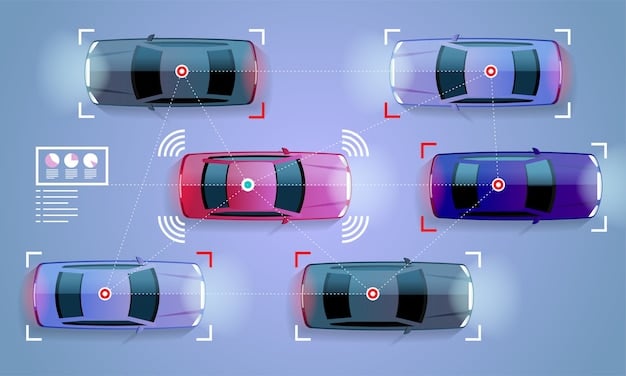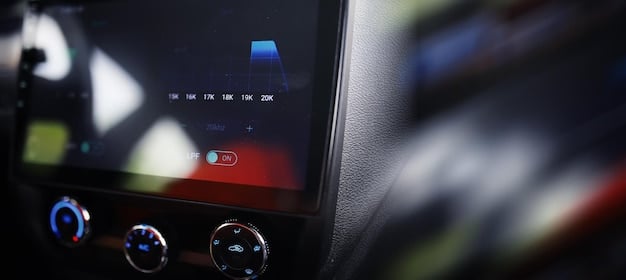How ADAS Prevents Collisions: Evolving for Safer Roads

Advanced Driver-Assistance Systems (ADAS) are rapidly evolving with features like improved sensors and AI-driven decision-making to significantly reduce the risk of collisions and enhance overall vehicle safety.
Advanced Driver-Assistance Systems (ADAS) are revolutionizing road safety by using cutting-edge technology to prevent collisions. These systems are constantly evolving with improvements in sensor technology, artificial intelligence, and data processing, making our roads safer for everyone.
Understanding the Core of Advanced Driver-Assistance Systems (ADAS)
ADAS technologies are designed to assist drivers and enhance vehicle safety. They use a combination of sensors, cameras, radar, and lidar to monitor the vehicle’s surroundings and provide alerts or interventions to prevent accidents. The ultimate goal is to reduce human error, which is a leading cause of collisions.
Key Components of ADAS
ADAS relies on several essential components working together to provide a comprehensive safety net. These components include sensors, processing units, and actuators, each playing a unique role in preventing collisions.
- Sensors: These detect the vehicle’s surroundings, including other vehicles, pedestrians, and road obstacles.
- Processing Units: These analyze the sensor data to make real-time decisions about when and how to intervene.
- Actuators: These execute the decisions made by the processing units, such as applying the brakes or adjusting the steering.
The Role of ADAS in Modern Vehicles
ADAS features are becoming increasingly common in modern vehicles, from entry-level models to luxury cars. These systems are designed to work in the background, providing unobtrusive assistance to drivers and enhancing overall safety. Their presence is gradually shaping the future of driving, moving towards more automated and safer transportation.

In summary, ADAS represents a major advancement in automotive safety, leveraging technology to prevent collisions and protect drivers and passengers. As these systems continue to evolve, they promise to make our roads safer for everyone.
How ADAS Prevents Different Types of Collisions
ADAS can prevent a wide range of collision types by providing drivers with timely warnings and interventions. These systems are designed to address common causes of accidents, such as distracted driving, speeding, and lane departures.
Preventing Rear-End Collisions
Rear-end collisions are among the most common types of accidents, often resulting from distracted driving or sudden braking. ADAS systems such as forward collision warning and automatic emergency braking (AEB) can significantly reduce the risk of these types of collisions.
Forward collision warning systems use sensors to detect the distance and speed of the vehicle ahead. If a potential collision is detected, the system provides an audible and visual warning to the driver. If the driver fails to respond, AEB can automatically apply the brakes to prevent or mitigate the impact.
Mitigating Side-Impact Collisions
Side-impact collisions, also known as T-bone accidents, can be particularly dangerous due to the limited protection offered by the vehicle’s doors. ADAS features like blind-spot monitoring and lane-keeping assist can help prevent these types of accidents.
- Blind-Spot Monitoring: This system uses sensors to detect vehicles in the driver’s blind spots, providing a warning when a lane change may be unsafe.
- Lane-Keeping Assist: This system uses cameras to monitor the vehicle’s position within its lane. If the vehicle begins to drift out of its lane, the system can provide a warning or even gently steer the vehicle back into the lane.
Reducing Pedestrian and Cyclist Accidents
Pedestrians and cyclists are particularly vulnerable in traffic accidents. ADAS technologies like pedestrian and cyclist detection can help prevent these types of collisions by alerting the driver to their presence and, if necessary, automatically applying the brakes.
By effectively addressing these common collision types, ADAS is making significant strides in improving road safety and reducing the number of accidents.
The Evolution of Sensor Technology in ADAS
The evolution of sensor technology is a key driver behind the advancements in ADAS. Improved sensors provide more accurate and reliable data, enabling ADAS systems to make better decisions and prevent collisions more effectively.
Advancements in Camera Technology
Cameras are an essential component of ADAS, providing visual information about the vehicle’s surroundings. Recent advancements in camera technology include higher resolution, wider dynamic range, and improved low-light performance, allowing ADAS systems to “see” more clearly.
These advancements enable ADAS systems to better detect and classify objects, such as vehicles, pedestrians, and traffic signs. The improved image quality also enhances the accuracy of lane-keeping assist and other vision-based features.
The Growing Use of Radar and Lidar
Radar and lidar are two complementary sensor technologies that provide information about the distance and speed of objects. Radar uses radio waves, while lidar uses laser beams. Both technologies have seen significant improvements in recent years.
Radar has become more compact and affordable, making it easier to integrate into vehicles. Lidar has become more accurate and reliable, thanks to advancements in laser technology and signal processing. Together, radar and lidar provide a comprehensive picture of the vehicle’s surroundings, even in challenging weather conditions.

In conclusion, the evolution of sensor technology is enabling ADAS to become more effective and reliable. As sensors continue to improve, ADAS systems will be able to prevent an even wider range of collisions.
AI and Machine Learning: Enhancing ADAS Capabilities
Artificial intelligence (AI) and machine learning are transforming ADAS by enabling systems to learn from data and make more intelligent decisions. These technologies are improving the accuracy and reliability of ADAS features, such as object detection and collision prediction.
The Role of AI in Object Detection and Classification
AI algorithms can be trained to recognize and classify objects in the vehicle’s surroundings, such as vehicles, pedestrians, and traffic signs. These algorithms use vast amounts of data to learn the characteristics of different objects and identify them accurately, even in challenging conditions.
AI-powered object detection enables ADAS systems to better understand the vehicle’s environment and anticipate potential hazards. This improved understanding allows ADAS to respond more quickly and effectively to prevent collisions.
Improving Collision Prediction with Machine Learning
Machine learning algorithms can analyze patterns in sensor data to predict the likelihood of a collision. These algorithms learn from historical data and identify factors that contribute to accidents, such as speed, distance, and road conditions.
- Speed: Analyzing vehicle speed relative to surroundings.
- Distance: Measuring proximity to other vehicles and obstacles.
- Road Conditions: Assessing weather and surface factors impacting safety.
By predicting collisions before they occur, ADAS can provide drivers with timely warnings and interventions, giving them more time to react and avoid accidents. These predictive capabilities are a major step forward in automotive safety.
The integration of AI and machine learning is significantly enhancing the capabilities of ADAS, making roads safer through smarter and more responsive systems.
The Future of ADAS: Towards Fully Autonomous Driving
The future of ADAS is closely linked to the development of fully autonomous driving. As ADAS technologies continue to improve, they are paving the way for vehicles that can drive themselves without human intervention.
Levels of Automation in Vehicles
The Society of Automotive Engineers (SAE) has defined six levels of automation, ranging from Level 0 (no automation) to Level 5 (full automation). Current ADAS systems typically operate at Level 2, which involves partial automation of steering and acceleration/deceleration.
Level 3 automation, which allows the vehicle to handle most driving tasks in certain conditions, is beginning to emerge. Level 4 automation, which enables the vehicle to drive itself in almost all conditions, is still under development. Level 5 automation, which would eliminate the need for a human driver altogether, is the ultimate goal.
Challenges and Opportunities in Autonomous Driving
Autonomous driving presents several technical and regulatory challenges. One of the biggest challenges is ensuring the safety and reliability of autonomous vehicles in all driving conditions. Other challenges include developing appropriate regulations and addressing ethical concerns.
Despite these challenges, autonomous driving offers tremendous opportunities. Autonomous vehicles could reduce traffic congestion, improve fuel efficiency, and provide mobility to people who are unable to drive themselves. They could also create new business models and transform the transportation industry.
The journey toward fully autonomous driving is gradual, with ADAS playing a critical role in bridging the gap. Continuous advancements in ADAS technologies are steadily moving us closer to this transformative future.
Challenges and Limitations of Current ADAS Technology
While ADAS technologies have significantly improved vehicle safety, they are not without their challenges and limitations. Understanding these limitations is important for drivers to use these systems effectively and avoid over-reliance.
Environmental Factors and Sensor Reliability
ADAS relies on sensors to perceive the vehicle’s surroundings, and these sensors can be affected by environmental factors such as weather, lighting, and road conditions. Heavy rain, snow, fog, and bright sunlight can all degrade sensor performance, reducing the accuracy and reliability of ADAS features.
Sensor reliability is also affected by dirt, debris, and damage. Regular cleaning and maintenance are essential to ensure that ADAS sensors function properly. Drivers should be aware of these limitations and adjust their driving accordingly in challenging conditions.
Avoiding Over-Reliance on ADAS
One of the biggest challenges in using ADAS is avoiding over-reliance on these systems. ADAS is designed to assist drivers, not replace them. Drivers should remain alert and engaged in the driving task, even when ADAS features are active.
- Stay Alert: Always pay attention to the road and surroundings.
- Engage: Actively participate in the driving process.
- Understand Limitations: Be aware of the system’s boundaries.
Over-reliance on ADAS can lead to complacency and reduced awareness, increasing the risk of accidents. Drivers should be trained to use ADAS features responsibly and understand their limitations.
Acknowledging and understanding the challenges and limitations of ADAS technology is crucial for maximizing its benefits and ensuring continued safety on the roads.
| Key Point | Brief Description |
|---|---|
| 🛡️ Collision Prevention | ADAS uses sensors and AI to prevent various collision types. |
| 📡 Sensor Evolution | Camera, radar, and lidar advancements enhance ADAS capabilities. |
| 🧠 AI Integration | AI and machine learning improve object detection and collision prediction. |
| 🚗 Autonomous Future | ADAS is paving the way for fully autonomous driving systems. |
Frequently Asked Questions (FAQ)
▼
ADAS stands for Advanced Driver-Assistance Systems. It includes electronic technologies that assist drivers in driving and parking functions, aiming to enhance vehicle safety.
▼
ADAS prevent collisions by using sensors like cameras, radar, and lidar to monitor the vehicle’s surroundings and provide warnings or interventions, such as automatic braking or steering adjustments.
▼
ADAS limitations include reduced sensor performance in adverse weather, potential for over-reliance by drivers, and the systems needing regular maintenance to ensure they function properly.
▼
AI and machine learning enhance ADAS by improving object detection accuracy, predicting potential collisions, and enabling the system to learn and adapt to different driving conditions over time.
▼
The future of ADAS involves moving towards fully autonomous driving, with continued improvements in sensor technology, AI capabilities, and regulatory frameworks to ensure safety and reliability.
Conclusion
In conclusion, Advanced Driver-Assistance Systems (ADAS) are transforming the automotive industry and making significant strides in improving road safety. Through continuous innovation and technological advancements, ADAS is paving the way for a future where collisions are minimized, and driving is safer for everyone.





